An ultra-quick recipe for Japanese mochi
Homemade green tea mochi is soft, chewy, and sweet, with a delicious matcha flavor and a beautiful green color.
This classic Japanese treat is easy to make at home—and better than your favorite restaurant’s, satisfaction guaranteed!
Plus, you can customize the filling (or filling, if we’re being simple) with sweet red bean paste, strawberry, or ice cream for ice cream mochi. Black sesame paste is fantastic too. It takes less than 15 minutes to make these matcha mochi, and they’re perfect as a dessert after a meal or as a snack with a hot cup of green tea.

What is mochi?
Mochi—more precisely, daifuku—are Japanese confections made with a filling wrapped in a layer of very chewy, sweet glutinous rice dough.
They’re popular worldwide, and it’s rare these days to meet someone who hasn’t seen them. As for tasting them, people tend to either love them or hesitate—but even that’s becoming rarer.
Daifuku or mochi?
Marketing can be misleading. What we commonly call mochi are actually daifuku, while mochi traditionally refers to the rice dough itself. It can be sweet or savory and is used in many different Japanese preparations.
For a modern parallel, in my circle some people call galette des rois a “frangipane,” but technically frangipane is just the almond cream that fills the galette. Same idea here: the term mochi for daifuku has become so popular that, while purists may complain, most people will understand you perfectly if you say mochi instead of daifuku.
That said, while trivial for most, this fun fact might help you impress a date at a fancy Japanese restaurant—Valentine’s Day is coming up, after all…
Personally, I’ll use the terms interchangeably in this article.

Inside, mochi (抹茶大福) can hold all kinds of fillings: sweet red bean paste, mung bean paste, ice cream, and my favorite, black sesame paste.
In this recipe, I make the mochi with green tea (matcha) and fill them with red bean paste. They look great, but you can easily customize them with your favorite fillings—no stress. You don’t even have to use matcha; make them plain if you like.
How to make homemade mochi?
We use the microwave method to prepare the mochi dough—it’s the simplest way and takes only a few minutes.
Whisk together the glutinous rice flour, sugar, and matcha powder. Add the water and whisk until completely dissolved.
Cover the bowl loosely with plastic wrap or a kitchen towel. Microwave on high for 2 minutes.

Remove and stir with a damp spatula. Cover and microwave for 30 seconds more, until the dough turns slightly translucent.
Transfer the mochi dough to parchment paper dusted with cornstarch. Dust more cornstarch over the dough. Divide into 4 equal portions and flatten each into a circle. You can easily stretch the dough with your hands.
Scoop some red bean paste and place it in the center of each mochi wrapper. Pinch the four corners of the wrapper together, then pinch the remaining edges to seal.
Pat the base of each mochi with cornstarch. Gently brush the assembled matcha mochi with a pastry brush to remove any excess cornstarch.
How to store mochi?
Store in an airtight container in the refrigerator; they’ll keep for up to 2 days. They taste best the day they’re made.

What does matcha mochi taste like?
The mochi layer is sticky-chewy with a lovely earthy matcha flavor (if you love matcha, you’ll be thrilled). The red bean paste filling is sweet and creamy—I’m a fan.
How to make ice cream mochi?
In summer, alongside a Korean melon bingsu, you might crave something extra refreshing. While we’re on Korean sweets, try gyeongdan—the Korean mochi.
You have two options:
- Make the classic recipe, then freeze.
- Make the dough and wrap it around the ice cream or sorbet of your choice. Work quickly. Freeze, then enjoy 1 hour later.

Which flour to use for mochi?
Use glutinous rice flour—nothing else will do. There’s no substitute. It’s responsible for mochi’s signature texture. It’s the same flour used for dango.

Ingredients
- 50 g glutinous rice flour
- 25 g sugar
- 0.5 tsp matcha powder
- 90 ml water
- cornstarch, for dusting
- 200 g red bean paste sweetened (or any filling you like)
Instructions
- In a microwave-safe bowl, whisk together the flour, sugar, and matcha powder. Add the water and whisk until smooth.50 g glutinous rice flour, 25 g sugar, 0.5 tsp matcha powder, 90 ml water
- Loosely cover the bowl with plastic wrap or a kitchen towel. Microwave on high for 2 minutes. Remove and stir with a damp spatula.
- Cover and microwave for another 30 seconds, until the dough is slightly translucent.
- Place a sheet of parchment paper on your work surface and generously dust it with cornstarch.cornstarch, for dusting
- Transfer the mochi dough onto the parchment. Dust the top with more cornstarch. Knead briefly.
- Divide the dough into 4 equal pieces. Flatten each into a circle with your hands.
- Place the red bean paste in the center of each dough round.200 g red bean paste
- Gather the edges to enclose the filling and pinch to seal.
- Gently brush the assembled matcha mochi to remove any excess cornstarch.

